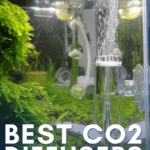If you want to have a vivid and densely planted freshwater aquarium, you have to fertilize your plants with carbon. Carbon isn’t easily supplemented in a liquid or solid form like other fertilizers and is usually delivered as a gas instead. To blend carbon dioxide gas into your aquarium water efficiently, you’ll need the best CO2 diffuser.
Quick Comparisons of the 5 Best Aquarium CO2 Diffusers
| IMAGE | BRAND | DETAILS | |
|---|---|---|---|
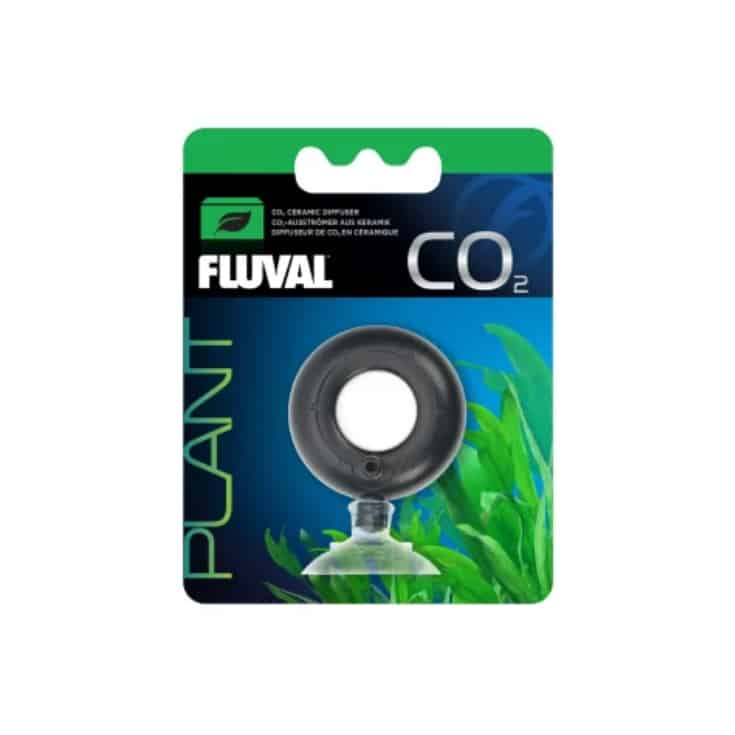 | Fluval Ceramic CO2 Diffuser |
| View Product |
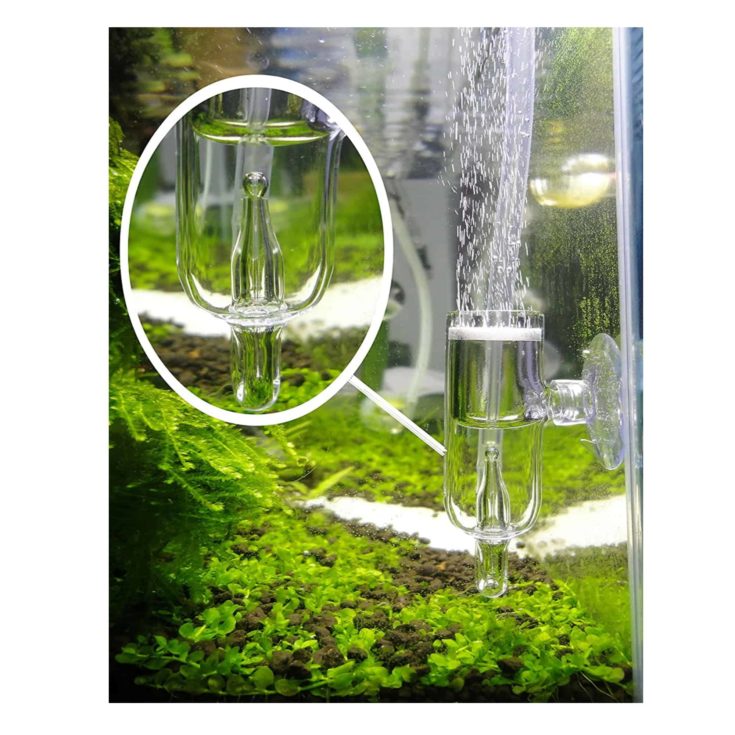 | JARDLI Pollen Glass CO2 Diffuser with Bubble Counter |
| View Product |
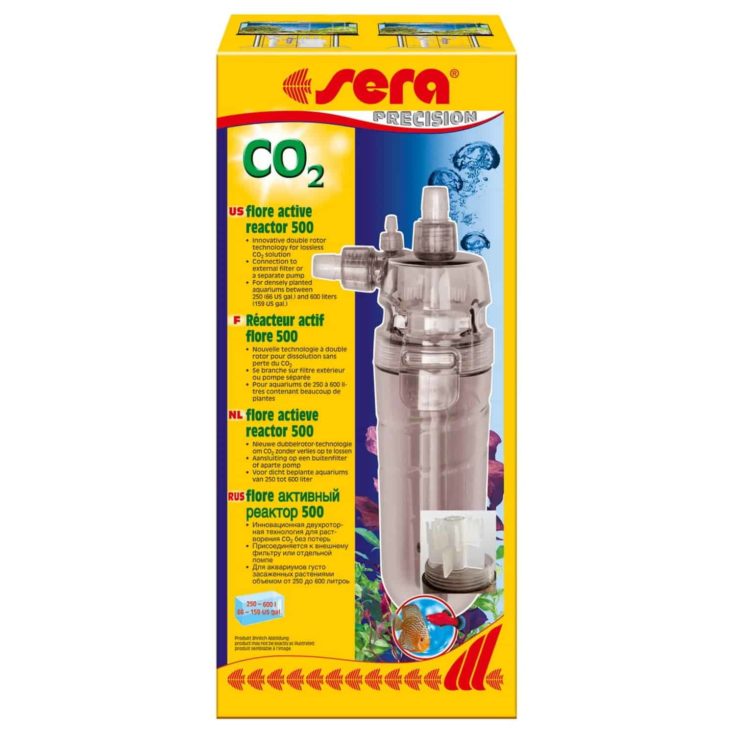 | Sera Flore CO2 Active Reactor 500 |
| View Product |
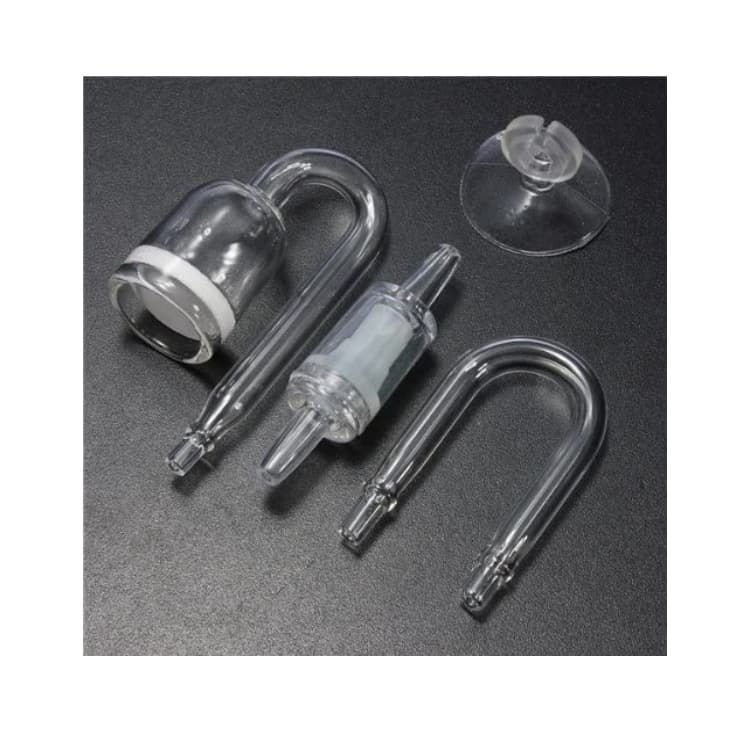 | STARSIDE Aquarium CO2 Regulator Kit |
| View Product |
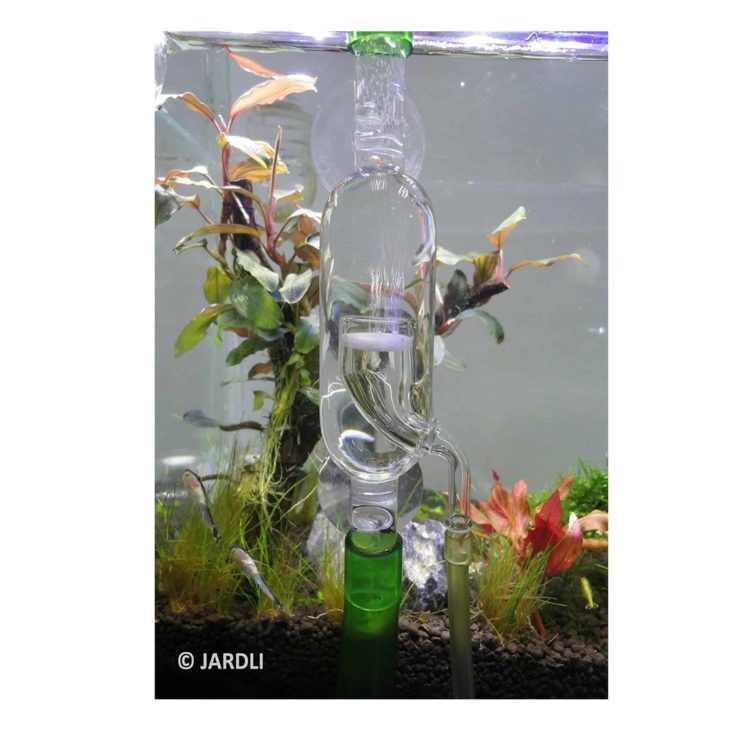 | JARDLI Glass Inline CO2 Atomizer Diffuser System |
| View Product |
Introduction To Aquarium CO2 Diffusers
Carbon is an essential element for animals and plants. Plants use carbon dioxide gas (CO2) as part of the process of turning light into food for growth and reproduction, known as photosynthesis. Without going too heavy into the chemistry, let’s explore this process for a second.
Terrestrial plants pull CO2 from the atmosphere and break the bonds between the carbon and two oxygen molecules. As you may remember from your high school biology lessons, plants then utilize the carbon to make sugars (plant food) and release the oxygen back into the atmosphere. But what about aquatic plants?
How Do Underwater Plants Get Carbon?
Outdoors, the constant cycle of evaporation and rainfall mixes atmospheric CO2 into bodies of water. Fine CO2 bubbles become suspended in the water column and only slowly dissipate into the atmosphere. Underwater plants are specially adapted to pull this dissolved CO2 from the water and utilize it for photosynthesis.
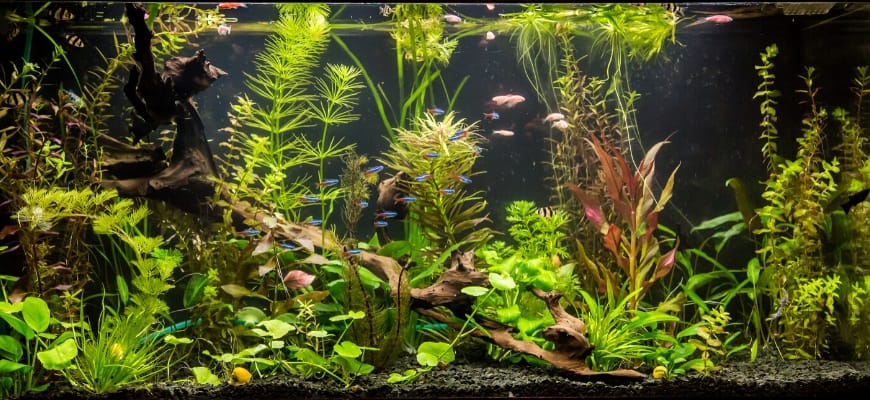
This cycle presents a problem for plant-loving aquarists, though. How do you get CO2 gas to dissolve into your aquarium water? CO2 injection systems and low-pressure DIY CO2 kits can easily produce the gas, but you’ll still need a way to suspend the gas in your aquarium water. That’s where a good CO2 diffuser comes in.
What is a CO2 Diffuser and How Does it Work?
CO2 diffusers take the gas produced by your injection system and mix it with water to make fine, microscopic CO2 bubbles. As the bubbles float in your aquarium, the CO2 is dissolved into the water column, where your plants can take up and utilize it. The speed at which this happens is directly related to the size of the diffused bubbles.
Small bubbles have more surface area in proportion to their volume than large bubbles, so finer bubbles allow more CO2 to dissolve into the water in the same amount of time and are more efficient. Large bubbles often break the surface before the CO2 can be fully absorbed, which lowers the efficiency of your system.
Depending on their design, CO2 diffusers either:
- Mix CO2 and water together to form a mist of microbubbles, which are released in the water to circulate around your tank (reactor and some in-line types).
- Or they pass the large CO2 bubbles through a fine screen or membrane to produce a stream of fine bubbles before they are released into the water column (ceramic, some in-line and airstone diffusers).
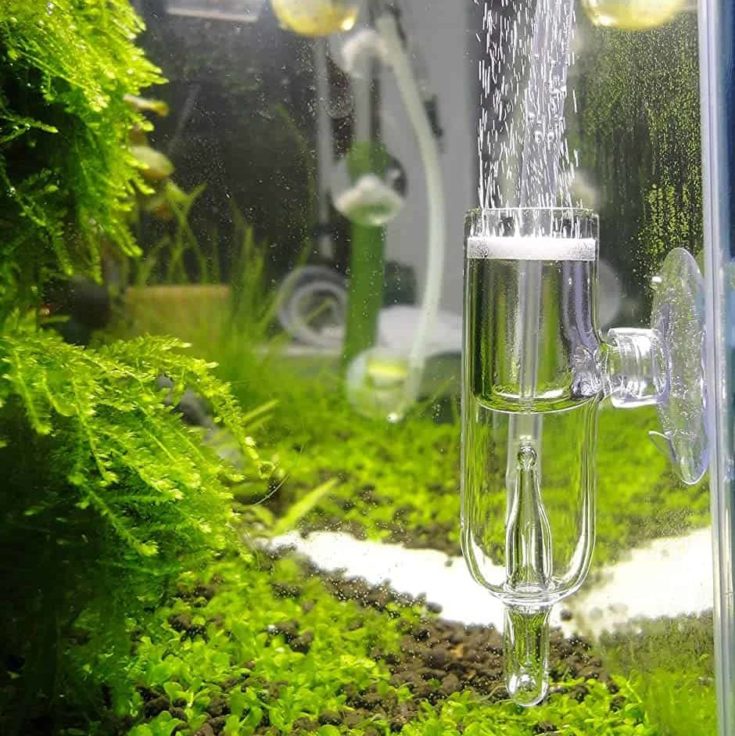
- Some diffusers also increase the amount of time the bubbles are in contact with the water, which improves the rate of CO2 absorption and saturation in your tank (reactor, ceramic and ladder diffusers).
Do You Need a CO2 Diffuser?
If you’re using a carbon injection system for your planted tank then you definitely need a CO2 diffuser to get the most out of it. If you run your injection tubing into your aquarium without a diffuser, the large bubbles will float straight up and release CO2 into the air instead of in the water. Diffusers are the solution to a big-bubble problem!
Benefits of Using a CO2 Diffuser
The primary reason to use a CO2 diffuser is to make your carbon generating system more efficient. Without a diffuser to control the size of the bubbles being released into your tank, your injection system may waste CO2 and not be able to deliver enough dissolved carbon to meet the needs of your plants.
Types of CO2 Diffusers
The exact method a CO2 diffuser uses to break large bubbles into small bubbles or mix CO2 and water together varies depending on their design. Let’s take a look at the most common types of CO2 diffusers for home aquariums:
CO2 Reactors

CO2 reactors are the premium way to deliver carbon to your planted tank. These automated blenders mix your tank water and the CO2 from your injection system until nearly all the CO2 is dissolved, resulting in the highest efficiency of any type of diffuser.
They are also the most expensive type of diffuser, however, and not suitable for use with most low-pressure and DIY CO2 generators. You’ll also need a powerful filter or pump to power the blades. They’re not always the easiest to install, but if you want the most efficient diffuser, a CO2 reactor could be the way to go.
Ceramic CO2 Diffuser
Some of the most attractive and cost-effective diffusers are those that use a ceramic disk or thin ceramic membrane to create small bubbles of CO2. They are often crafted of clear glass or stainless steel for easy cleaning and have a disk or layer of ceramic in the middle which the CO2 passes through.
This is a very broad category, and the installation and function can vary widely depending on their design. Some ceramic diffusers sit inside your aquarium, while others can attach in-line to your filter or be hung externally on your tank. They are usually not very expensive, which is another bonus.
In-Line CO2 Diffuser
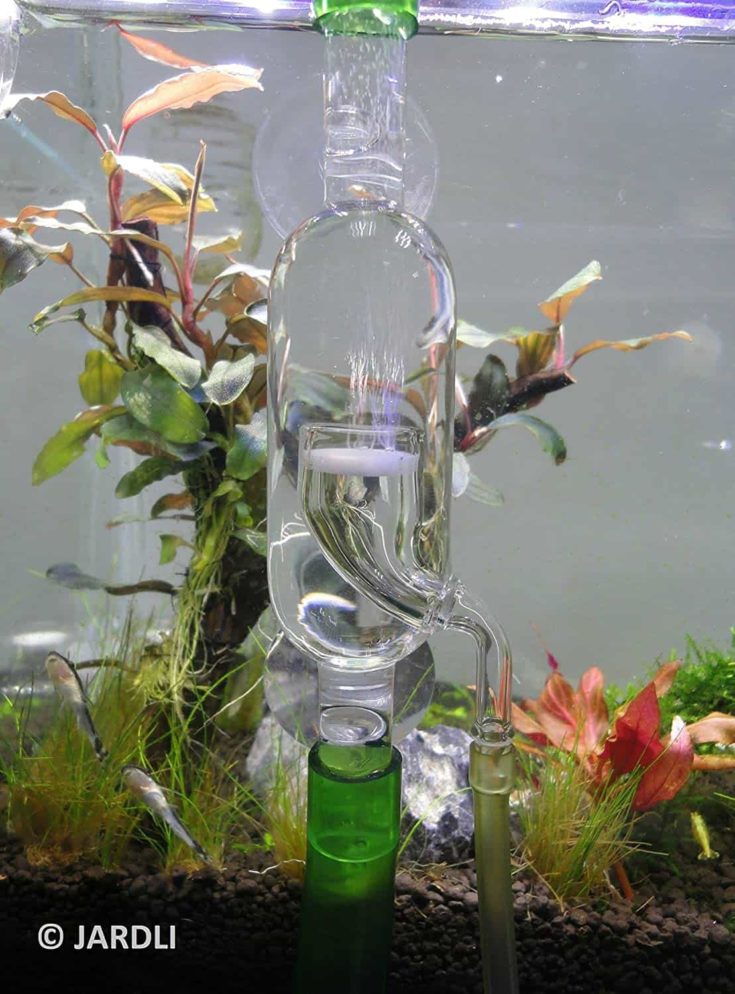
In-line diffusers hook directly into your canister filtration system near where the water returns via the outflow. This means they usually can be hidden behind or underneath your tank and reduce the clutter inside your aquarium. They are more efficient than the ceramic diffusers but not as effective as CO2 reactors.
In-line diffusers are harder to install and regulate since they rely on your filter’s motor to push the water through the diffuser. They also don’t work with HOB or internal filters. It’s much more common to see them on large tanks with powerful canister systems.
Ladder CO2 Diffuser
A ladder CO2 diffuser is a simple and inexpensive glass or plastic device that extends the amount of time bubbles are in contact with the water before being released into your tank. They increase the efficiency of low-pressure and DIY CO2 generators and are the ideal choice for nano tanks and small planted aquariums.
Airstone Diffuser
Airstone CO2 diffusers are the same coarse stones used to increase water oxygenation in a tank, but send out bubbles of CO2 instead of oxygen. They are not efficient and not very effective, either. Personally, I’d save my money and invest in a more useful system rather than use an airstone.
CO2 Reactor
Benefits
- Most efficient type CO2 diffuser
- Blends 98-100% of the generated CO2 into your water
- Can be located next to or under the tank to reduce clutter
- Best type of CO2 diffuser for large aquarium
Disadvantages
- Expensive
- Requires a pressurized CO2 injection system
- Needs a powerful filter or pump to power the chopping blades
Ceramic Diffuser
Benefits
- Most common type of CO2 diffuser for Nano tanks and small aquariums
- Uses a ceramic disk or thin ceramic membrane to break CO2 into tiny bubbles
- May be made from either glass or stainless steel
- Generally inexpensive and available in a wide number of sizes and designs
- Specific benefits vary depending on the design
Disadvantages
- Ceramic varies in quality and not all ceramic diffusers perform equally well
- Ceramic is difficult to clean and easily clogs
- May require regular replacement
- Not as efficient as a reactor or in-line diffusers
- Materials are often fragile and easily broken during maintenance
In-line Diffuser
Benefits
- Hooks into your canister filtration system near the outflow
- Can be hidden behind or underneath your tank to reduce clutter
- Increases CO2 saturation by extending the amount of time the bubbles are in contact with the water
Disadvantages
- Harder to install than a reactor or ceramic diffuser
- Requires a powerful canister filter or separate pump to push water through
- If the system leaks or water backflows into the diffuser you could have an expensive and messy clean-up
Ladder Diffuser
Benefits
- Inexpensive plastic or glass tube that extends the amount of time CO2 bubbles are in contact with water before being released into the tank
- Ideal option for nano tanks and small aquariums with low-pressure or DIY CO2 generators
Disadvantages
- Not as efficient as reactors, ceramic diffusers or in-line diffusers
Airstone Diffuser
Benefits
- Just like an oxygenating airstone except CO2 is bubbled through
- Cheapest type of diffuser
Disadvantages
- Least efficient and desirable type of diffuser
- Not recommended for any type of aquarium
How to Choose Your CO2 Diffuser
It’s not as easy to pass along recommendations for CO2 diffusers as it is for other types of equipment like filters, LED lights, and substrate. The best diffuser for your tank varies depending on the type of carbon injection and filtration systems you’re using. You’ll definitely have to do some research to find the best option for your tank.
Let’s take a look at some of the things you should consider when picking a diffuser:
Ideal Type of Diffuser for Your Set Up
There are three parts to a carbon injection system for a planted tank: a CO2 generator, a CO2 regulator, and a CO2 diffuser. The ideal diffuser for your tank will depend on the type of generator and regulator you’re using. If you’re using pressurized CO2 cartridges, you’ll need a diffuser designed for high-pressure CO2.
Your type of filtration system matters as well for many types of CO2 diffusers. Most in-line diffusers need a specific amount of flow to push CO2 through the disk or membrane to make the tiny bubbles. If you’re using it with the wrong kind of pump, you won’t get any bubbles.
Tank Size and Flow
Size matters somewhat when it comes to CO2 diffusers, but it’s more of a problem to choose a diffuser that’s too small rather than one that’s bigger than necessary. A small diffuser will be limited by the maximum amount of CO2 that it can handle in bubbles per minute. It’s not very efficient to use a small diffuser in a large tank.
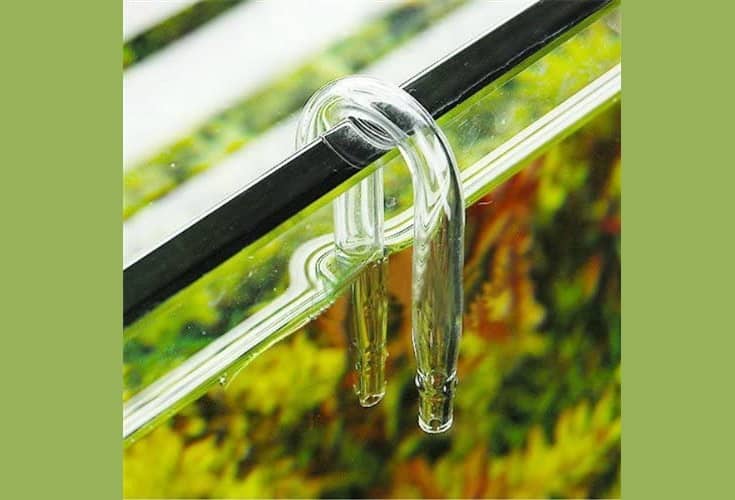
More than the size of your tank, CO2 diffuser placement is what really counts. You want to maximize the amount of time the bubbles spend in the water before they break the surface. Avoid placing it near the top or by your filter intakes, and check the flow pattern in your tank to find the best spot to maximize circulation.
Type and Materials
Like everything in your tank, CO2 diffusers have to be cleaned and maintained on a regular schedule. Minerals in your water can clog the ceramic disks and membranes used to generate the bubbles, and algae frequently builds up on these devices. Look for diffusers that are easy to remove for cleaning, and easy to clean too.
While glass is the most common material in CO2 diffusers, stainless steel might be a better option if you’re particularly clumsy. They aren’t as attractive, but they also don’t break as easily. Diffusers made from glass-like resins are stronger and more durable as well. Reactors usually come with acrylic or stainless steel chambers.
Kit Inclusions
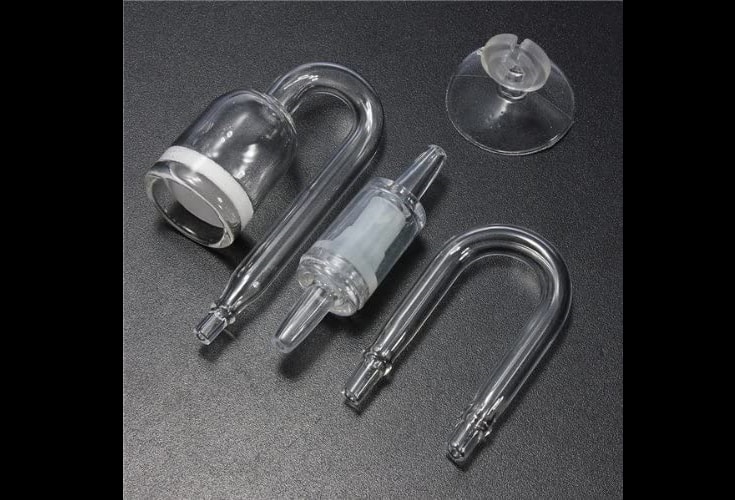
Sometimes it’s easier to buy a diffuser as part of a kit. You can either invest a big chunk of change into a complete CO2 system that includes a generator, regulator, and diffuser, or you can look for a cheaper diffuser-only kit if that’s all you need to replace or upgrade.
Some diffusers come with bubble counters or glass/resin U-bends in addition to the diffuser. If you need the extra parts, it could be a good deal and save you some money if you get a diffuser kit. You can also buy your CO2 diffuser individually if you prefer.
How To Install Your CO2 Diffuser
There are a ton of diffusers on the market, so it’s hard to generalize about the installation process. CO2 diffusers are usually quite easy to install, although the specific instructions will vary depending on your type and how it connects to your CO2 generator, regulator, and filtration system.
I can pass on a few tips about your diffuser set-up, however:
- First, always soak your diffuser in your tank for a while before installing it.
- The exact length varies by manufacturer, but 30 minutes to 24-hours usually works.
- This allows the ceramic membrane to fully fill with water, helps expel air from the system and fills the diffuser as well.
- Diffusers won’t work when they are dry, so the soaking step is critical.
- Be sure that you’ve added a check valve between your diffuser and the generator or regulator to prevent water from flowing back into the generator when your system is off (for instance, at night).
- Use the recommended type of tubing for your diffuser.
- Be sure to seal any loose fittings with plumber’s tape or silicone to prevent a loss of pressure or leaks from the system.
- Pressurized CO2 systems may require barb fittings to prevent the tubing from blowing off when the system starts up.
Top 5 Aquarium CO2 Diffuser Reviews
There are hundreds of diffusers on the market, and many look nearly identical to each other. With so many options, it can be a challenge to find the right CO2 diffuser for your planted tank. The following diffusers are some of the very best, so let’s take a look and see which would be the ideal choice for your aquarium!
1. Fluval Ceramic CO2 Diffuser

- Diffuser Type: Ceramic
- Tank Size: under 30 Gallons
- Dimensions: 3.5 inches long
If you’re using the Fluval-brand pressurized CO2 system on a small aquarium under 30-gallons in capacity, then the ideal replacement would be this small Fluval ceramic diffuser. With its wide ceramic disk, this diffuser produces a consistent stream of fine bubbles. It’s easy to install, and while it’s not the most attractive device, it gets the job done. It’s a very inexpensive replacement part too, which is helpful. It’s perfect for Fluval systems and works with most pressurized CO2 generators as long as they produce at least 30 psi (pounds per square inch). This is a very simple diffuser and comes with a bit of protection for the ceramic disk and a suction cup for keeping it in place.
It’s not my favorite diffuser, however, even for Fluval CO2 systems. The diffuser is not very easy to clean and the ceramic disk is not removable from the casing. While you can soak the whole thing in bleach or hydrogen peroxide to remove stains or algae, the connections seem to wear quickly, and this diffuser needs frequent replacement. The Fluval is harder to break than glass diffusers, so for some users, it might be a more durable and cost-effective option. Even if you have to replace it more frequently due to its marginal quality, you probably won’t break it when you remove it for maintenance.
| PROS | CONS |
|---|---|
|
|
2. JARDLI Pollen Glass CO2 Diffuser with Bubble Counter

- Diffuser Type: Ceramic
- Tank Size: 20 Gallons and under
- Dimensions: 3.1 x 0.8 inches
Another option for pressurized CO2 systems would be this small glass diffuser from Jardli. The thicker ceramic membrane produces a fine mist of bubbles about the size of pollen grains, which help the CO2 dissolve into your aquarium water. This is a simple but very attractive diffuser that sits inside your tank. It comes complete with a built-in bubble counter, so if you don’t already have a counter on your system this could be a good pick. The ceramic plate is about 0.8 inches in diameter, so this diffuser would be ideal for nano tanks under 20 gallons in capacity.
The main downsides to this diffuser are related to the construction materials. Glass is fragile, and you’ll have to remove the diffuser from your tank for cleaning. You can’t replace the ceramic disk, either, so if you break the bubble counter or glass tube you’ll have to replace the entire device. I also wouldn’t recommend this diffuser if you don’t have a pressurized CO2 system, because low-pressure and DIY systems rarely produce enough psi to move the CO2 through the ceramic membrane. This is a good option for aquascaped nano tanks, though.
| PROS | CONS |
|---|---|
|
|
3. Sera Flore CO2 Active Reactor 500

- Diffuser Type: Reactor
- Tank Size: 66 to 159 Gallons
- Dimensions: N/A
If you want the best CO2 reactor, this model from Sera is considered top-of-the-line for smaller aquariums. It’s the ideal size for a planted tank under 160 gallons and it works with both pressurized and low-pressure CO2 injectors. With dual impeller blades, the Sera can diffuse up to 500 CO2 bubbles per minute into your aquarium. The Sera can be installed in-line as part of your canister filtration system, or you can use it with a pump right inside your aquarium. This flexibility allows you to place it in the optimal location based on your tank’s flow patterns and the location of your intake and outtake tubes.
CO2 reactors are substantially more efficient than other designs, so if you want to ensure that most of your system’s CO2 becomes available to your aquatic plants, using a reactor is the way to go. This is an ideal reactor for tanks starting at about 50 gallons but is probably wasteful if installed in smaller planted tanks. Like all CO2 reactors, the Sera is especially noisy right after being installed or maintained, since it takes time for the air bubbles to work their way out. This isn’t the easiest diffuser to install, either, but Sera has top-notch customer service and they are very helpful if you run into problems. I would definitely choose this diffuser over any other on my list if it’s appropriate for your tank.
| PROS | CONS |
|---|---|
|
|
4. STARSIDE Aquarium CO2 Regulator Kit

- Diffuser Type: Ceramic
- Tank Size: up to 100 Gallons
- Dimensions: 3.2 x 3.2 x 3.2 inches
If you like the look of a glass diffuser but want a more inclusive kit that’s a bit less fragile than standard glass, this CO2 regulator kit from Starside could be a good pick for your rimless tank. The resin-based glass is stronger and more flexible than regular glass and is less liable to break during maintenance. This is a very attractive diffuser set as welland would look great in most planted aquariums. The kit includes the ceramic diffuser, a check valve, a glass U-bend tube and a suction cup for securing the device in place inside your tank. The U-bend replaces the plastic tubing that so easily kinks and reduces your CO2 flow.
The large ceramic membrane makes this system ideal for tanks up to 100 gallons in capacity. It does still require a pressurized CO2 system, though, and won’t work well with low-pressure generators. The resin-based glass is sturdier and more flexible, but you can still easily break it during maintenance if you’re not careful. The biggest problem with the Starside is that the U-bend is too narrow to fit on tanks with the normal bevel or rim around the top. You’d have to shave down the plastic to make room for it if you decide to try it on anything but a rimless tank. But if you have a big rimless planted tank, this could be the perfect diffuser for you.
| PROS | CONS |
|---|---|
|
|
5. JARDLI Glass Inline CO2 Atomizer Diffuser System

- Diffuser Type: In-line
- Tank Size: N/A
- Dimensions: 5.3 inches tall
For an attractive and easy to clean in-line CO2 diffuser, this beautiful design from Jardli could be the way to go. The large glass diffuser hooks right into your canister filtration system, so you don’t have to clutter your tank with an internal CO2 diffuser. It works with any canister filters that use 0.5-inch wide tubing. You can use this diffuser in a tank of any size, because your filter controls the water flowing through the ceramic membrane. You can adjust your CO2 levels by simply adjusting your filter’s flow rate and the amount of CO2 entering the line. It works best with pressurized CO2, but many have modified it to work with their DIY generators as long as the pressure isn’t too low.
This isn’t a complete kit, however. You’ll still have to use a check valve when you connect it to your CO2 canister, and a bubble counter makes estimating your CO2 levels a lot easier. Since this unit sits behind or below your tank, it’s less likely to develop algae growth and is easier to remove for cleaning. Glass is still fragile, however, so you’ll have to be careful during maintenance. This might not be the least-expensive diffuser on my list, but next to the Sera CO2 reactors this is still one of the best options if you want to maximize your CO2 diffusion.
| PROS | CONS |
|---|---|
|
|
Conclusion
As you can see, there’s a lot to consider when you’re researching the best aquarium CO2 diffusers. The ideal type of diffuser depends partly on the size of your aquarium, but is mostly related to the type of CO2 generator and filtration system you’re running on your planted tank. We’d love to hear about your experience with CO2 diffusers!
To sum things up quickly:
- I’d go with the Sera CO2 reactor for a tank over 50 gallons.
- The Jardli pollen diffuser is an excellent option for nano tanks 20 gallons and under.
- The Starside kit is an ideal choice for rimless aquariums and includes a glass U-bend, too.
